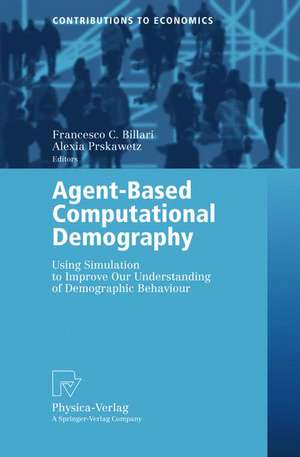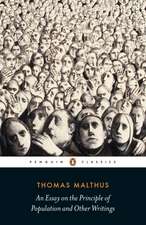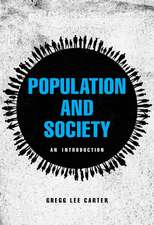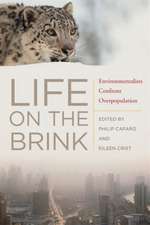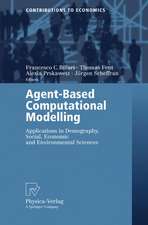Agent-Based Computational Demography: Using Simulation to Improve Our Understanding of Demographic Behaviour: Contributions to Economics
Editat de Francesco C. Billari, Alexia Prskawetzen Limba Engleză Paperback – 17 apr 2003
Din seria Contributions to Economics
- 18%
 Preț: 1001.81 lei
Preț: 1001.81 lei -
 Preț: 90.83 lei
Preț: 90.83 lei - 15%
 Preț: 649.06 lei
Preț: 649.06 lei - 18%
 Preț: 1109.92 lei
Preț: 1109.92 lei - 24%
 Preț: 657.06 lei
Preț: 657.06 lei - 18%
 Preț: 976.54 lei
Preț: 976.54 lei - 17%
 Preț: 361.01 lei
Preț: 361.01 lei - 18%
 Preț: 1027.83 lei
Preț: 1027.83 lei -
 Preț: 283.93 lei
Preț: 283.93 lei - 15%
 Preț: 644.95 lei
Preț: 644.95 lei - 15%
 Preț: 638.24 lei
Preț: 638.24 lei -
 Preț: 394.29 lei
Preț: 394.29 lei - 15%
 Preț: 637.78 lei
Preț: 637.78 lei - 18%
 Preț: 723.69 lei
Preț: 723.69 lei - 15%
 Preț: 635.47 lei
Preț: 635.47 lei - 15%
 Preț: 634.00 lei
Preț: 634.00 lei -
 Preț: 392.75 lei
Preț: 392.75 lei -
 Preț: 383.33 lei
Preț: 383.33 lei - 15%
 Preț: 637.28 lei
Preț: 637.28 lei - 15%
 Preț: 636.80 lei
Preț: 636.80 lei - 18%
 Preț: 950.96 lei
Preț: 950.96 lei - 15%
 Preț: 634.68 lei
Preț: 634.68 lei -
 Preț: 387.38 lei
Preț: 387.38 lei - 15%
 Preț: 647.27 lei
Preț: 647.27 lei - 15%
 Preț: 636.63 lei
Preț: 636.63 lei - 15%
 Preț: 639.73 lei
Preț: 639.73 lei -
 Preț: 385.62 lei
Preț: 385.62 lei - 15%
 Preț: 641.85 lei
Preț: 641.85 lei - 20%
 Preț: 649.60 lei
Preț: 649.60 lei - 15%
 Preț: 641.71 lei
Preț: 641.71 lei -
 Preț: 387.96 lei
Preț: 387.96 lei - 15%
 Preț: 645.47 lei
Preț: 645.47 lei -
 Preț: 385.08 lei
Preț: 385.08 lei - 15%
 Preț: 646.62 lei
Preț: 646.62 lei -
 Preț: 383.33 lei
Preț: 383.33 lei - 15%
 Preț: 638.43 lei
Preț: 638.43 lei -
 Preț: 381.21 lei
Preț: 381.21 lei - 15%
 Preț: 642.51 lei
Preț: 642.51 lei - 15%
 Preț: 637.78 lei
Preț: 637.78 lei - 15%
 Preț: 641.71 lei
Preț: 641.71 lei -
 Preț: 384.70 lei
Preț: 384.70 lei -
 Preț: 379.86 lei
Preț: 379.86 lei -
 Preț: 378.34 lei
Preț: 378.34 lei -
 Preț: 384.70 lei
Preț: 384.70 lei -
 Preț: 388.52 lei
Preț: 388.52 lei - 15%
 Preț: 641.71 lei
Preț: 641.71 lei -
 Preț: 381.00 lei
Preț: 381.00 lei - 15%
 Preț: 644.95 lei
Preț: 644.95 lei -
 Preț: 386.00 lei
Preț: 386.00 lei
Preț: 636.80 lei
Preț vechi: 749.19 lei
-15% Nou
Puncte Express: 955
Preț estimativ în valută:
121.85€ • 127.48$ • 101.22£
121.85€ • 127.48$ • 101.22£
Carte tipărită la comandă
Livrare economică 03-17 aprilie
Preluare comenzi: 021 569.72.76
Specificații
ISBN-13: 9783790815504
ISBN-10: 3790815500
Pagini: 224
Ilustrații: IX, 210 p.
Dimensiuni: 155 x 235 x 12 mm
Greutate: 0.32 kg
Ediția:2003
Editura: Physica-Verlag HD
Colecția Physica
Seria Contributions to Economics
Locul publicării:Heidelberg, Germany
ISBN-10: 3790815500
Pagini: 224
Ilustrații: IX, 210 p.
Dimensiuni: 155 x 235 x 12 mm
Greutate: 0.32 kg
Ediția:2003
Editura: Physica-Verlag HD
Colecția Physica
Seria Contributions to Economics
Locul publicării:Heidelberg, Germany
Public țintă
ResearchCuprins
Introduction: Agent-Based Computational Demography.- 1 Introduction: Demographers Are Almost Absent in a Flourishing Field of Research.- 2 The Gap Between Theory and Techniques in Demography.- 3 The Added Gains of Agent-Based Computational Demography.- 4 Difficulties and Challenges for Agent-Based Computational Demography.- 5 Agent-Based Models in Demography: Examples in this Book.- 6 Discussion: The Potential Roles of Agent-Based Computational Demography.- References.- Data, Models, Theory and Reality: The Structure of Demographic Knowledge.- 1 Introduction.- 2 The Methodology of Ansley J. Coale.- 3 Nathan Keyfitz on the Fruitfulness of Abstract Modelling.- 4 A Model-Based View of Science.- 5 Elements of Science.- 6 Assessing Scientific Knowledge.- 7 Coda: On the Dangers of Dichotomies.- References.- The Role of Agent-Based Modelling in Demographic Explanation.- 1 Introduction.- 2 The Problem of Thin Social Processes.- 3 The Problem of Relating Existing Theories to ABM.- 4 Representing Social Context.- 5 Representing Cognitive Complexity.- 6 Collecting Appropriate Data.- 7 Conclusion.- References.- Diffusion Processes in Demographic Transitions: A Prospect on Using Multi Agent Simulation to Explore the Role of Cognitive Strategies and Social Interactions.- 1 Introduction.- 2 Behavioural Rules in MAS.- 3 Decision Making.- 4 The Consumat Approach.- 5 A Possible Application of the Consumat Approach: The Diffusion of Contraceptives.- 6 Prospects for Applications of the Consumat Approach in Demographic Research Questions.- 7 Conclusions.- References.- The Collapse of the Berlin Wall: Simulating State -Level East to West German Migration Patterns.- 1 Introduction.- 2 Historical Background.- 3 Evidence on East to West German Migration.- 4 Theoretical Framework.- 5 Data and Stylized Facts.- 6 An Agent-Based Simulation Model.- 7 Conclusions.- References.- Agent-Based Modeling of Householders’ Migration Behavior and Its Consequences.- 1 Introduction.- 2 Agent-Based Modelling as a Tool for Analysis of Complex Multi-Agent Systems.- 3 Abstract Models of Residential Migration.- 4 A Real-World Agent-Based Model of Residential Choice and Migration.- 5 Discussion.- 6 Conclusions.- References.- Population-Wide Marriage Patterns Produced by Individual Mate-Search Heuristics.- 1 Introduction.- 2 The Demographic Patterns of Age at Marriage.- 3 Modeling Sequential Search Processes.- 4 Implications and Conclusions.- References.- On the Cultural Evolution of Age-at-Marriage Norms.- 1 Introduction.- 2 Background.- 3 An Agent-Based Model.- 4 Results and Discussion.- 5 Summary and Prospects for Future Research.- References.- Bringing Behavior Back into Micro-Simulation: Feedback Mechanisms in Demographic Models.- 1 Introduction.- 2 Data and Methods.- 3 Results.- 4 Summary of Findings.- References.- Consequences of Mortality Crises in Pre-Modern European Towns: A Multiagent-Based Simulation Approach.- 1 Introduction.- 2 James.- 3 Implementation in James.- 4 First Experiments and Some Preliminary Results.- 5 Conclusions and Future Prospects of the Model.- References.- Agents, Hierarchies and Sustainability.- 1 Setting: A Sugarscape-Like Grid.- 2 Agents: Overview.- 3 Experiments.- 4 Conclusion.- References.
Textul de pe ultima copertă
Agent-Based Computational Demography (ABCD) aims at starting a new stream of research among social scientists whose interests lie in understanding demographic behaviour. The book takes a micro-demographic (agent-based) perspective and illustrates the potentialities of computer simulation as an aid in theory building. The chapters of the book, written by leading experts either in demography or in agent-based modelling, address several key questions. Why do we need agent-based computational demography? How can ABCD be applied to the study of migrations, family demography, and historical demography? What are the peculiarities of agent-based models as applied to the demography of human populations? ABCD is of interest to all scientists interested in studying demographic behaviour, as well as to computer scientists and modellers who are looking for a promising field of application.
Caracteristici
Includes supplementary material: sn.pub/extras
